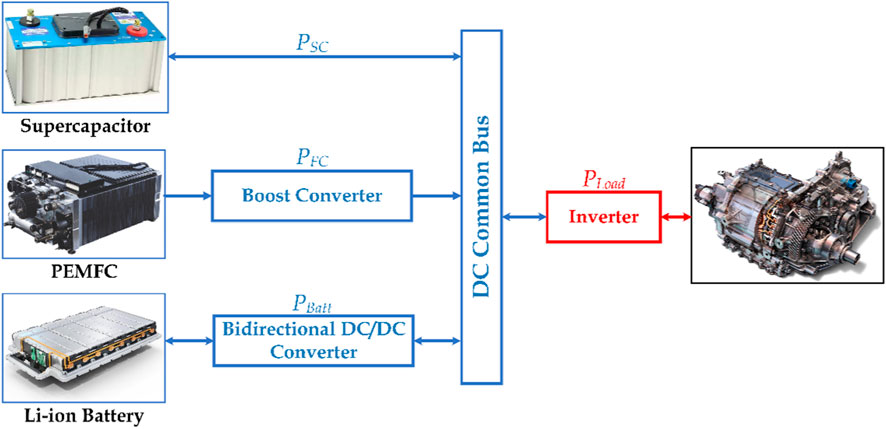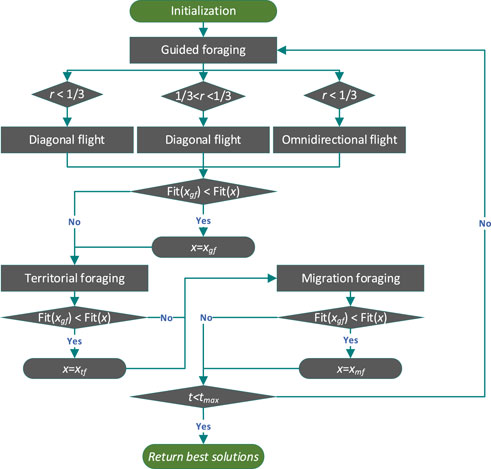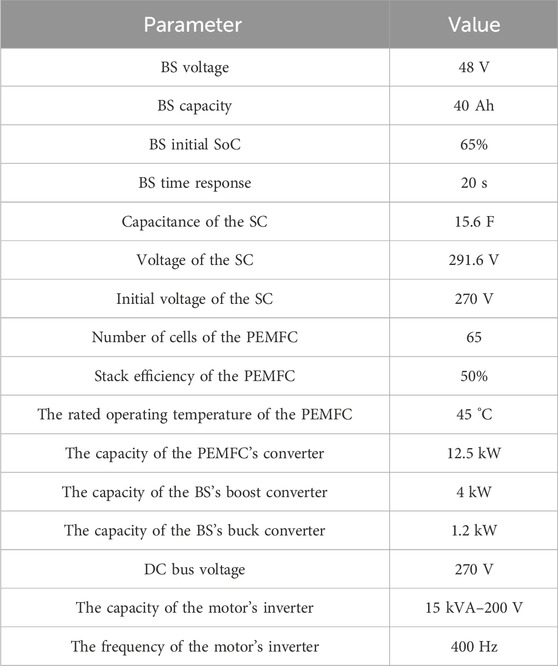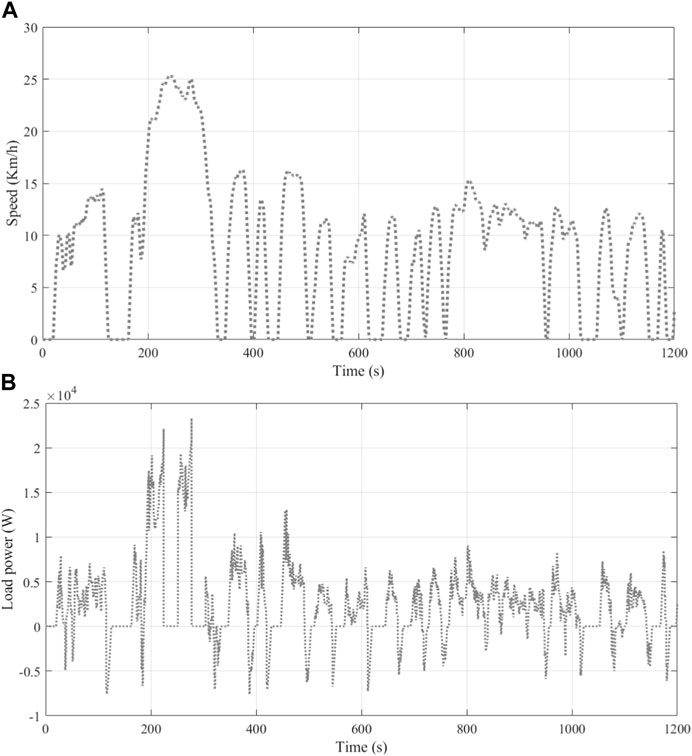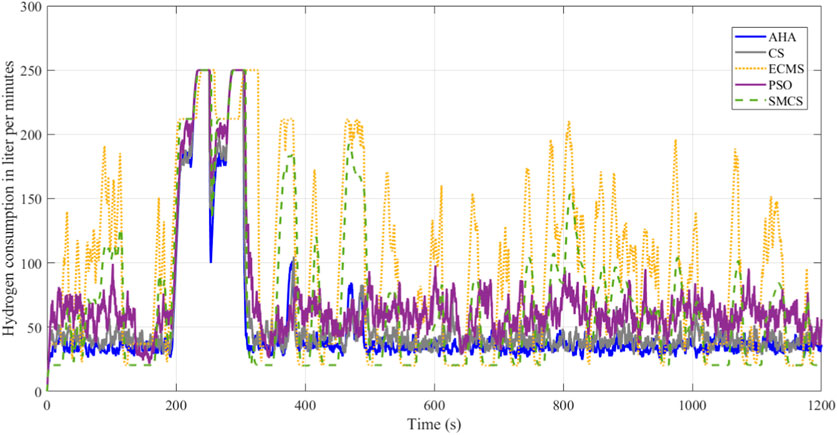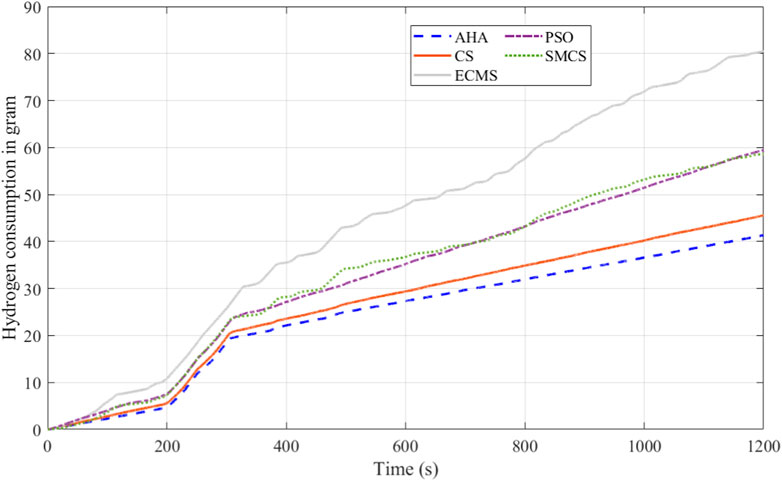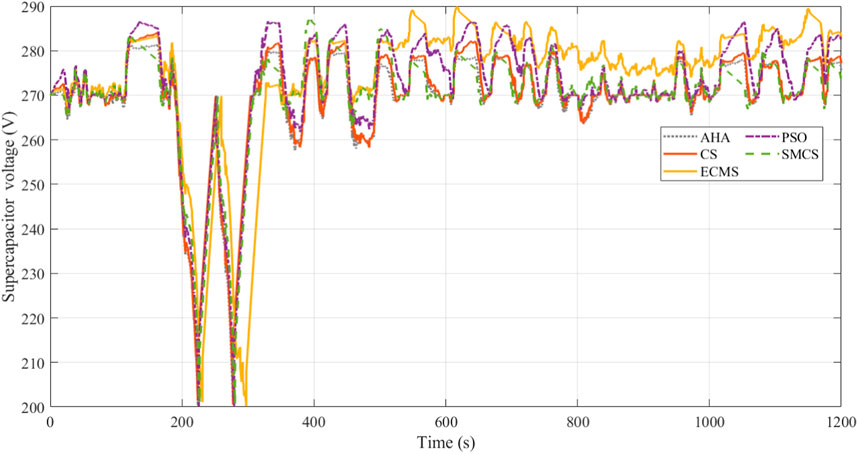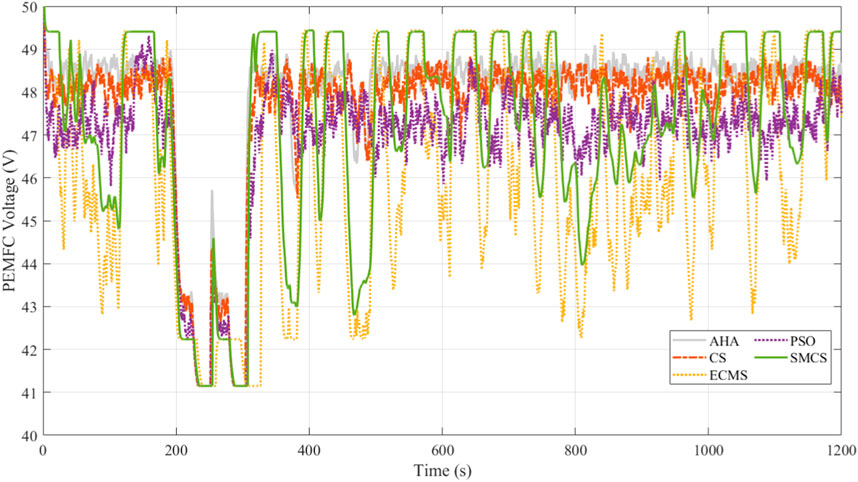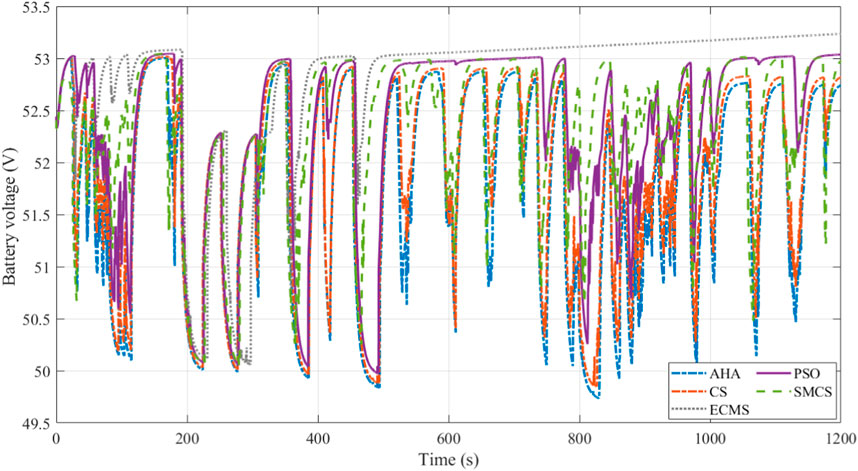- 1Department of Electrical Engineering, College of Engineering, Prince Sattam bin Abdulaziz University, Al-Kharj, Saudi Arabia
- 2Department of Electrical Engineering, College of Engineering in Wadi Alddawasir, Prince Sattam bin Abdulaziz University, Al-Kharj, Saudi Arabia
- 3Department of Mechanical Engineering, Tuskegee University, Tuskegee, AL, United States
- 4Department of Mechanical Engineering, Faculty of Engineering, Tafila Technical University, Tafila, Jordan
The automotive sector is experiencing rapid evolution, with the next-generation emphasizing clean energy sources such as fuel-cell hybrid electric vehicles (FCHEVs) due to their energy efficiency, eco-friendliness, and extended driving distance. Implementing effective energy management strategies play a critical role in optimizing power flow and electrical efficiency in these vehicles. This study proposes an optimized energy management strategy (EMS) for FCHEVs. The suggested EMS introduces a hybridization between the equivalent consumption minimization strategy (ECMS) and the Artificial Hummingbird Algorithm (AHA). The Federal Test Procedure for Urban Driving (FTP-75) is employed to evaluate the performance of the proposed EMS. The results are assessed and validated through comparison with outcomes obtained by other algorithms. The findings demonstrate that the proposed EMS surpasses other optimizers in reducing fuel consumption, potentially achieving a 48.62% reduction. Moreover, the suggested EMS also yields a 15.45% increase in overall system efficiency.
1 Introduction
Energy scarcity and environmental preservation garner significant attention in various nations, and the extensive usage of fossil fuels exacerbates ecological concerns. Among the different energy sources and technologies that can be used to replace classical energy is hydrogen energy, where hydrogen fuel cells (FCs) are seen as potential alternatives for achieving zero-pollution emissions (Luderer et al., 2021). The transportation industry is mandatory for daily life, and the car sector is vital in many countries. Currently, conventional fuel cars continue to dominate the market, emitting pollutant gases. Notably, the transportation industry contributes significantly to greenhouse gas emissions (Yan et al., 2023), which promotes decarbonization by replacing classical fossil fuels with clean fuels like hydrogen (Chang et al., 2019; Zuo et al., 2023a; Zuo et al., 2023b). Usually, proton exchange membrane fuel cells (PEMFCs) are used in the FCHEVs. The PEMFC, which utilizes hydrogen to generate heat, electric power, and water, has a slow response to changes in driving conditions and encounters challenges in adapting to these changes (Ghoniem et al., 2023a; Chen et al., 2024). Rapid acceleration and deceleration have an impact on the FC’s longevity, and the hydrogen reaction in the fuel cell is frequently less than the load rate. Despite these difficulties, battery systems (BSs) and supercapacitors (SCs) are frequently used with fuel cells in hybrid energy storage systems for power applications (Wang et al., 2022a). Lithium-ion batteries have been getting more and more attention in the last few years (Li et al., 2024), which makes them a feasible solution for hybridization with the SCs (Zuo et al., 2022). This lowers the amount of hydrogen used, shrinks the size of the FC, and improves the power system efficiency (Li et al., 2021; Wang et al., 2022b). The growing significance of hydrogen energy in the transportation sector is demonstrated by the widespread usage of FC-based hybrid systems in FC-hybrid automobiles and other transportation equipment (Saleet et al.). FCs serve as the main source in FCHEVs, with SCs or batteries serving as supplemental power sources. These vehicles must navigate challenging road conditions and abrupt power changes, which might shorten the FC’s lifespan (Zhang et al., 2019; Ghoniem et al., 2023b). When load demand is high, BSs and SCs can simultaneously act as supplementary energy sources to recover surplus energy and power FCs (Kasimalla and Velisala, 2018). Because of their high specific power, quick dynamic response, and energy recovery, SC can react quickly to sudden changes in load demand (Kasimalla and Velisala, 2018). The hybridization of these components enhances the operational conditions of the fuel cell (FC) system, resulting in improved performance.
The effectiveness and performance of FCHEVs are significantly influenced by the energy management Strategies (EMSs) (Sulaiman et al., 2018). Its primary purpose is to distribute power among various energy sources to accomplish two objectives: (1) lowering the amount of hydrogen consumed or limiting the amount of equivalent energy consumed (Li et al., 2016); and (2) prolonging the life of the fuel cell, which also increases the hybrid system’s economics (He et al., 2022). In the literature, EMSs can be categorized into several categories. The two main ones are rule-based and optimization-based EMSs (Zhang et al., 2020). The rule-based approach is the first kind of EMS utilized to maximize fuel cell efficiency. It entails acquiring the fuel cell’s power map and modifying the power distribution in accordance with the status of the power system. This category includes deterministic rule-based strategies like State machine control strategy (SMCS) (Kasimalla and Velisala, 2018) and fuzzy rule-based strategies. Fuzzy logic controllers have found extensive use in EMSs due to their simplicity in design and implementation, although their performance remains somewhat dependent on the designer’s expertise (Sulaiman et al., 2015; Xue et al., 2020). Nevertheless, there are drawbacks to this approach, including characteristics that are influenced by test operating circumstances and a lack of flexibility to adjust to various situations. Furthermore, to tackle these challenges, a digital control scheme is recommended for integrating solar, battery, and fuel cells. This scheme also elucidates the energy management system employed by diverse control units of electric vehicles in (Mathesh and Saravanakumar, 2023a).
Optimization-based EMSs are rooted in solving a predetermined objective function, either minimization or maximization. These EMS are classified into two sub-categories: online and offline strategies. Offline EMS involves solving the optimal control problem for a predefined mission (speed profile). On the other hand, online EMS are dynamic and robust, as they evolve in real-time according to the changes in the objective function values. Recently, there has been an increased interest in real-time optimum energy management systems (Benhammou et al., 2023). Large data sets are used by learning-based methodologies to train parameters for ideal control. Jia et al. (2024) introduced a learning-based model predictive EMS with health-aware control to ensure the stable, efficient, and healthy operation of FCHEVs. To address the economy and durability concerns of FCHEVs, Song et al. (2024) proposed an energy management strategy utilizing nonlinear model predictive control (NMPC) technology, dynamic programming, and the Markov Monte Carlo method for optimal control. Furthermore, Huang and He (2024) presented a data-driven EMS based on deep reinforcement learning aimed at enhancing the fuel economy of FCHEVs and improving the training effectiveness of the proposed EMS. Rasool et al. (2023) emphasized the significance of EMSs in optimizing the performance of FCHEVs. This highlighted the need for additional research and the integration of advanced EMS techniques with multi-objective algorithms to improve fuel economy, reliability, and cost-effectiveness. Huo et al. (2023) proposed an improved EMS for FCHEVs using a soft actor-critic algorithm. Oubelaid et al. (2023) introduced a multi-stage power management strategy designed for HEVs with the primary goal of safeguarding FCs against potential damage resulting from sudden load variations. This strategy incorporated a fuzzy EMS and coordinated switching strategy to facilitate efficient utilization and precise control of FC power. Zhang et al. (2023) proposed a multi-level EMS for FCHEVs with the objective of enhancing the energy utilization rate of the system. This strategy was specifically designed to elevate the overall efficiency of the FCHEV hybrid power system. Xu et al. (2023) introduced an adaptive model predictive control-based EMS for FCHEVs aimed at enhancing fuel efficiency and mitigating degradation of the onboard FC hybrid systems.
Generally, most of the EMSs concentrate on maximizing energy usage and prolonging the life of FC and other parts. Figure 1 depicts all the categorizations of EMSs.
Recent references have demonstrated that the highest performance levels can be reached through the integration of online strategies and metaheuristic optimization algorithms (MAs), and these solutions have gained immense popularity (Antarasee et al., 2022). One approach to enhance EMS efficiency involves the use of a genetic fuzzy-based EMS, as proposed in (Ahmadi et al., 2018). Additionally, authors in (Antarasee et al., 2022) introduced an enhanced EMS that is based on a genetic algorithm. Furthermore, authors in Rezk et al. (2019) have put forward optimizations for ECMS and EEMS using the Salp Swarm Algorithm (SSA), and the Mine Blast Algorithm (MBA). Among these approaches, EEMS-SSA produced the most favorable. In the comparative study conducted in (Zhao et al., 2019), various MAs were used, like MBA, Artificial Bee Colony (ABC), Cuckoo Search (CS), Grey Wolf Optimization (GWO), and Whale Optimization Algorithm (WOA).
The goal of this study is to explore the optimal utilization of fuel through the application of the Artificial Hummingbird Algorithm (AHA), a bio-inspired metaheuristic algorithm, to minimize the cost function of the equivalent consumption minimization strategy (EEMS). The primary contribution outlined in this manuscript is the implementation of an EMS that effectively reduces fuel consumption and enhances electrical efficiency. The proposed EMS is designed to decrease the hydrogen consumption of the power system, drawing inspiration from the ECMS and AHA. A comparison is drawn between the proposed ECMS-AHA and conventional approaches such as ECMS, ECMS-based cuckoo search (CS), particle swarm optimization (PSO), and state machine control strategy (SMCS). The key objectives of this research are as follows.
• Develop an optimized EMS for FCHEV applications to achieve improved fuel savings and higher electrical efficiency.
• Enhance the External Energy Maximization Strategy (EEMS) by integrating it with the AHA.
• Evaluate the proposed EMS using the Federal Test Procedure (FTP-75) driving profile and compare the results with classical ECMS, ECMS-PSO, ECMS-CS, and state machine control strategy (SMCS).
2 The proposed FCHEV system
The FCHEV, utilizing a combination of fuel cells (FC), a battery system (BS), and supercapacitors (SC), is constructed in an active topology to satisfy the traction system requirements of the vehicle’s engine. As depicted in Figure 2, the power system is composed of a PEMFC, a Lithium-ion BS, and a SC.
The FC plays a crucial role in controlling and maintaining the mean power required by the traction system, while the BS and supercapacitors provide additional support for the load during continuous and transient peak loading cases. These BSs ensure consistent power demands are met, whether during routine operation or sudden spikes in load power. The power system effectively manages varying load conditions, optimizing overall performance and efficiency. The motor traction forces (Fmt) are presented by the external forces applied to the external structure, as depicted in Eq. 1 (Zhao et al., 2019):
Where Fd is the demanded force of the motor, Frr is the rolling resistance force (as defined in Eq. 2), Far is the aerodynamic force applied on the front of the vehicle (as defined in Eq. 3), and Fup is the uphill driving force (as defined in Eq. 4). Each force can be defined as follows (Mathesh and Saravanakumar, 2023b):
where
where
Where m represents the vehicle mass (kg), g is the acceleration gravity (m/s2), and α represents the angle of the road.
• PEMFC: FC combines hydrogen and oxygen, resulting in water and electricity by passing the atoms through a proton exchange membrane. The membrane, made of perfluoro sulfonic acid polymer, selectively allows protons to flow. PEMFCs offer high power capacity compared to their volume, fast startup dynamic, and moderate operating temperatures, making them widely used in many applications (Shaari and Kamarudin, 2019; Alnaqbi et al., 2022).
• Supercapacitor (SC): Often referred to as ultracapacitors, SCs are electrical energy storage devices that store and release energy via the electrostatic charge principle. They are made consisting of two electrodes immersed in an electrolyte solution, which, when voltage is applied, accumulates electrical charges to form a double-layer capacitance. Supercapacitors have a long cycle life, high power, and fast charge/discharge cycles.
• Battery system: Lithium-ion batteries are represented by several electrochemical models, including the Randles Circuit, Thevenin Model, and the Internal Resistance Battery Model (Fotouhi et al., 2016). One popular model for characterizing electrical properties is the Shepherd Model (Shepherd, 1965). The discharge voltage of the battery is calculated using a variety of factors, including open circuit voltage, exponential voltage losses, polarization voltage losses, and ohmic losses (Mayyas et al., 2013).
• Converters: Bidirectional DC/DC boost converters for the BS and SC coupling to the common DC bus, enabling power flow in either direction. By lowering current fluctuations, multilevel converters enhance the DC bus’s power quality (Mayyas et al., 2011). By transferring power to the DC bus with minimal changes in current, a multilayer boost converter shields the FC stack from possible harm. A bidirectional DC/AC converter powers the vehicle motor, enabling power flow in both directions for regenerative braking and propulsion, hence increasing system efficiency.
3 Energy management strategies
• SMCS: the state machine control strategy is a strategy based on switching rules (Rasool et al., 2023). It is based on selecting the operating state based on the inputs’ states: the motor demanded power and the battery SOC. Stateflow is used to create the state machine, and the continuous control system is built as an optimum setpoint generator coupled to local controllers.
• ECMS: ECMS is an algorithm designed for instantaneous optimization that uses Pontryagin’s Minimum Principle to compute the equivalence factor, a penalty for battery power consumption (Musardo and Rizzoni, 2005). It maximizes fuel economy by maintaining the battery state of charge below its maximum threshold. ECMS estimates the equivalence factor using instantaneous or prediction-based estimation, ensuring the battery state stays within certain limits (Rezaei et al., 2018). The objective function of ECMS is expressed by Eq. 5 (Njoya Motapon et al., 2014):
Where PFC represents the FC power, Pbat represents the battery power, and α is the penalty factor. The following constraints (Eqs 6–8) should be considered while forming the problem (Njoya Motapon et al., 2014):
Where the SoCmin is the lower SoC, Vbatt, and Qbatt are the battery’s voltage and capacity.
• Optimized ECMS-based AHA:
The cost function is minimized through the utilization of the artificial hummingbird algorithm (AHA), a metaheuristic optimization algorithm, as opposed to the PMP minimization strategy. Considering the constraints specified in Eqs 6–8, this cost function can be minimized in the capacity of a metaheuristic optimizer. The online optimization procedure regulates the power transfer within the power system in order to minimize the aforementioned equation. More details about the AHA are provided in Section 4.
4 Artificial hummingbird algorithm (AHA)
AHA replicates the flight abilities and clever food detection tactics observed in the natural habitat of the hummingbirds. Hummingbirds tend to visit food sources with the highest nectar volume, requiring a high nectar-refilling rate and long unvisited time. In the AHA algorithm, hummingbirds determine the highest visit-level food sources and choose the one with the highest nectar-refilling rate as their target food source. They can then fly towards it for feeding. This algorithm includes three phases: guided foraging, territorial foraging, and migration foraging.
• Guided foraging:
In this stage, the AHA algorithm makes use of three flight skills: omnidirectional, axial, and diagonal flights. Hummingbirds can fly in three different directions: omnidirectionally, which allows them to project any direction onto any of the three coordinate axes, and diagonally, which allows them to travel from one corner to the other. In this algorithm, all the candidate (x) solutions are updated in the guided foraging if there are better solutions as presented in Eq. 9:
where xtarget is the target position, a is guiding gain, and D expresses the flight patterns that can be expressed by Eq. 10:
Where d expresses the search space dimensions, r1 is a random gain.
• Territorial foraging:
After visiting its target food source and ingesting the nectar from flowers, a hummingbird may seek a new food source rather than visit other sources. As a result, it can easily go to a nearby area within the search space range, where it is possible to discover a fresh and rich source or a potential improvement over the one it already has. The following is the mathematical equation representing the hummingbirds’ local search for a potential food source as part of this foraging technique. The territorial foraging phase model can be presented in Eq. 11:
Where b is a normal distribution with null mean and unitary standard deviation that expresses the territorial factor.
• Migration foraging:
One technique for figuring out a hummingbird’s rate of migration is the AHA algorithm. The hummingbird will travel to a more distant food source if there is inadequate nectar replenishment in an area with a high rate of refilling. The hummingbird will migrate to a new randomly generated food source if the migration coefficient rises above a certain number of iterations. The visit table is then updated as a result of this migration foraging process. The migration foraging phase model can be formulated by Eq. 12:
where Lb and Ub are the lower and the upper boundaries of the search space, r is a random factor.
The optimization process diagram for AHA is shown in Figure 3.
5 Results and discussion
The simulation model is constructed and programmed in Matlab/Simulink 2022a, where the S-function block includes the proposed ECMS-AHA, where the inputs are the BS’s state of charge (SoC) and the motor demanded power. The current PI controllers are employed for controlling the FC and BS converters. The model’s S-function utilizes the inputs, namely, the battery SOC and load demand, to produce the reference currents for the FC and BS. All models are formulated by building upon the individual subsystem models outlined in Section 2. The simulation tests use the parameters provided in Table 1.
The SC is connected directly to the common DC bus, therefore, its voltage is the same as that of the voltage of the common DC bus. This last is adjusted by BS converters, and the required level is maintained with a straightforward Proportional-Integral (PI) controller. The PEMFC boost converter controls both input current and output voltage. The BS is charged and discharged using two DC/DC converters, which also control output voltage and restrict current. An inverter system satisfies voltage and frequency specifications while converting DC electricity to AC power. Figures 4A, B show the vehicle speed profiles according to the FTP-75 and motor load.
Figure 5 illustrates the real-time hydrogen consumption rate, measured in liters per minute, representing the variation in hydrogen consumption rate over time in response to the changes in operating conditions. The curves in Figure 5 portray the impact of each management strategy on hydrogen consumption. Specifically, the ECMS-AHA demonstrates an effective reduction in hydrogen consumption during peak times while maintaining minimal consumption at other times. This suggests that the ECMS-AHA strategy is designed to optimize hydrogen usage by adjusting parameters or operations in response to demand fluctuations.
Figure 6 illustrates the overall quantity of hydrogen used during the simulation time. The ECMS-AHA management approach demonstrates a notable reduction in overall fuel consumption compared to alternative methods or scenarios. Overall, the ECMS-AHA technique proved to be the most effective in optimizing hydrogen utilization during the study period.
For a thorough investigation of its performance, it was evaluated using two primary metrics: electrical efficiency and hydrogen consumption. The electrical efficiency, which expresses the total power losses, can be calculated as the ratio of supplied power to demanded power by the traction system.
- Regarding hydrogen consumption, the ECMS-AHA leads to a significant reduction in hydrogen consumption from 80.48 g to 41.35 g compared to SMCS, ECMS, CS, and PSO. This results in a decrease in hydrogen consumption by 29.47%, 48.62%, 9.29%, and 30.39%, respectively.
The methodology used to derive these findings is presented in Eq. 13:
where rECMS-AHA is the reduction ratio in the consumed fuel, fECMS-AHA is the consumed fuel by this strategy, and fECMS, SCMSC,SC,PSO represents the by ECMS, SMCS, SC and PSO strategies.
- In terms of electrical efficiency, the proposed strategy (ECMS-AHA) demonstrates improvements of 6.3%, 15.45%, 3.53%, and 16.62% compared to SMCS, ECMS, ECMS-CS, and ECMS-PSO, respectively. This demonstrates the capability of the proposed strategy to enhance load power supply while reducing power losses. The improvements in electrical efficiency demonstrated by the proposed strategy ECMS-AH compared to SMCS, ECMS, ECMS-CS, and ECMS-PSO can be attributed to the specific characteristics and capabilities of the AHA. The AHA may offer a more effective and efficient optimization approach compared to the algorithms used in SMCS, ECMS, ECMS-CS, and ECMS-PSO. The AH algorithm’s ability to explore and exploit the search space for optimal solutions could lead to significant improvements in electrical efficiency. Furthermore, ECMS-AH may demonstrate enhanced adaptability to dynamic system conditions, allowing it to make real-time adjustments and optimizations that result in improved electrical efficiency gains compared to the other strategies. Moreover, the AHA algorithm within the ECMS framework may excel in effectively balancing power management trade-offs, leading to better load power supply enhancement and reduced power losses. It is important to highlight that the variation in efficiency gains can be attributed to the differences in optimization algorithms, adaptability to dynamic system conditions, and the ability to effectively balance power management trade-offs. The distinctive approach of each strategy to optimization and control significantly influences the attained efficiency gains. For instance, when applied CS or PSO within the ECMS framework, the use of CS or PSO may enable better exploration and exploitation of the search space, leading to higher efficiency gains compared to other strategies. However, SMCS typically relies on predefined states and transitions, which may not be as adaptive or responsive to dynamic changes in the system’s operating conditions. This could result in suboptimal power management and efficiency.
These figures and indicators demonstrate that the utilization of ECMS-AHA in a PEMFC-integrated hybrid power system results in a reduction in hydrogen consumption.
Table 2 provides a numerical comparison of the considered management strategies, including hydrogen consumption, efficiency, the reduction ratio in hydrogen consumption, and the improvement ratio in efficiency. The comparison indicates the superiority of the ECMS-based AHA. Specifically, the ECMS-based AHA reduces hydrogen consumption from 80.48 to 41.35 g, resulting in a savings ratio of 30.39% compared to the standard ECMS method. Additionally, the ECMS-based AHA has improved its efficiency from 48.92% to 56.48%. These findings are visually represented in Figure 7, where the metrics for each management strategy are depicted in columns.
As depicted in Figure 8, the fuel cell (FC), which has relatively delayed reaction kinetics, assumes the predominant responsibility for supplying most of the load poder. Meanwhile, the battery system (BS) stores excess energy to ensure a constant power flow. In certain instances, the FC may require more time than expected to reach its reference output. Utilizing the stored energy in the battery during periods of high demand or in case of a power disruption in the fuel cell can enhance the system’s reliability. Additionally, supercapacitors (SCs) effectively manage sudden load fluctuations due to their rapid ability to store and discharge electrical energy.
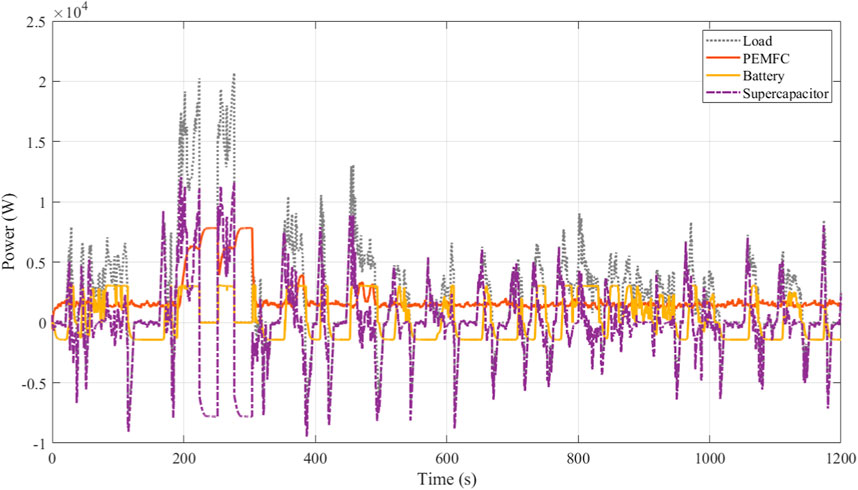
FIGURE 8. Dynamic response of the FC, the BS, and the SC as a function of the motor load power in using ECMS-AHA.
Figure 9 illustrates the voltage of the supercapacitor (SC). Variations in power absorption or release in the common bus result in voltage fluctuations. When power generation aligns with power demand, the SC voltage stabilizes at 270 V. However, during sudden load fluctuations, the SC voltage rapidly decreases as it discharges to meet the immediate power requirements of the traction system.
Figure 10 displays the outcomes of the voltage of the FC achieved using various control strategies. The suggested approach employs the FC with a more moderate response time when compared to alternative methods. This decision contributes to a prolonged state of health (SoH) for the FC, enhancing its longevity and efficacity.
Figure 11 provides a depiction of the battery voltage. In the case of the suggested technique incorporating AHA, the battery voltage exhibits significant fluctuations in voltage. The BS plays a crucial role in protecting the FC system and reducing its voltage fluctuations, leading to increased battery voltage variability.
6 Conclusion
This study presents an innovative energy management strategy (EMS) designed for a fuel cell hybrid electric vehicle (FCHEV) with a key focus on optimizing the EMS using the Artificial Hummingbird Algorithm (AHA). The primary goal of this approach is to enhance electrical efficiency and improve fuel economy. This study aims to develop an optimized EMS for FCHEV applications, enhance the External Energy Maximization Strategy (EEMS) with the AHA, and comprehensively evaluate the proposed EMS under the Federal Test Procedure (FTP-75) driving profile. The simulation results indicate substantial reductions in hydrogen consumption and enhancements in electrical efficiency when compared to alternative strategies such as SMCS, ECMS, ECMS-CS, and ECMS-PSO. Numerically, the proposed EMS achieved a noteworthy reduction in fuel consumption to 41.35 g, representing a 29.47% decrease compared to SMCS, a 48.62% decrease compared to ECMS, a 9.29% decrease compared to SC, and a 30.39% decrease compared to PSO. Moreover, the overall efficiency increased to 56.48%. These improvements are attributed to the specific characteristics and capabilities of the AHA, which offers a more effective and efficient optimization approach compared to the algorithms used in other strategies. The AHA algorithm’s ability to explore and exploit the search space for optimal solutions could lead to significant improvements in electrical efficiency. It is important to note that the real-time implementation of the presented strategy is constrained by the requirement for high-speed computing capability to effectively improve the objective function. However, it is anticipated that advancements in physical processing systems will soon overcome this limitation.
Data availability statement
The raw data supporting the conclusion of this article will be made available by the authors, without undue reservation.
Author contributions
MA: Conceptualization, Formal Analysis, Investigation, Methodology, Resources, Software, Validation, Writing–original draft, Writing–review and editing. HR: Conceptualization, Formal Analysis, Investigation, Methodology, Resources, Software, Validation, Visualization, Writing–original draft, Writing–review and editing. AA: Formal Analysis, Investigation, Methodology, Visualization, Writing–original draft, Writing–review and editing.
Funding
The author(s) declare that financial support was received for the research, authorship, and/or publication of this article. The authors extended their appreciation to Prince Sattam bin Abulaziz University for funding this research work through the project number (PSAU/2023/01/25913).
Conflict of interest
The authors declare that the research was conducted in the absence of any commercial or financial relationships that could be construed as a potential conflict of interest.
Publisher’s note
All claims expressed in this article are solely those of the authors and do not necessarily represent those of their affiliated organizations, or those of the publisher, the editors and the reviewers. Any product that may be evaluated in this article, or claim that may be made by its manufacturer, is not guaranteed or endorsed by the publisher.
References
Ahmadi, S., Bathaee, S. M. T., and Hosseinpour, A. H. (2018). Improving fuel economy and performance of a fuel-cell hybrid electric vehicle (Fuel-Cell, battery, and ultra-capacitor) using optimized energy management strategy. Energy Convers. Manag. 160, 74–84. doi:10.1016/j.enconman.2018.01.020
Alnaqbi, H., Sayed, E. T., Al-Asheh, S., Bahaa, A., Alawadhi, H., and Abdelkareem, M. A. (2022). Current progression in graphene-based membranes for low temperature fuel cells. Int. J. Hydrogen Energy 52, 800–842. doi:10.1016/j.ijhydene.2022.03.255
Antarasee, P., Premrudeepreechacharn, S., Siritaratiwat, A., and Khunkitti, S. (2022). Optimal design of electric vehicle fast-charging station’s structure using metaheuristic algorithms. Sustainability 15, 771. doi:10.3390/su15010771
Benhammou, A., Tedjini, H., Hartani, M. A., Ghoniem, R. M., and Alahmer, A. (2023). Accurate and efficient energy management system of fuel cell/battery/supercapacitor/AC and DC generators hybrid electric vehicles. Sustainability 15, 10102. doi:10.3390/su151310102
Chang, X., Ma, T., and Wu, R. (2019). Impact of urban development on residents’ public transportation travel energy consumption in China: an Analysis of hydrogen fuel cell vehicles alternatives. Int. J. Hydrogen Energy 44, 16015–16027. doi:10.1016/j.ijhydene.2018.09.099
Chen, Z., Zuo, W., Zhou, K., Li, Q., Yi, Z., and Huang, Y. (2024). Numerical investigation on the performance enhancement of PEMFC with gradient sinusoidal-wave fins in cathode channel. Energy 288, 129894. doi:10.1016/j.energy.2023.129894
Fotouhi, A., Auger, D. J., Propp, K., Longo, S., and Wild, M. (2016). A review on electric vehicle battery modelling: from lithium-ion toward lithium-sulphur. Renew. Sustain. Energy Rev. 56, 1008–1021. doi:10.1016/j.rser.2015.12.009
Ghoniem, R. M., Alahmer, A., Rezk, H., and As’ad, S. (2023b). Optimal design and sizing of hybrid photovoltaic/fuel cell electrical power system. Sustainability 15, 12026. doi:10.3390/su151512026
Ghoniem, R. M., Wilberforce, T., Rezk, H., As’ ad, S., and Alahmer, A. (2023a). Boosting power density of proton exchange membrane fuel cell using artificial intelligence and optimization algorithms. Membr. (Basel). 13, 817. doi:10.3390/membranes13100817
He, H., Jia, C., and Li, J. (2022). A new cost-minimizing power-allocating strategy for the hybrid electric bus with fuel cell/battery health-aware control. Int. J. Hydrogen Energy 47, 22147–22164. doi:10.1016/j.ijhydene.2022.04.297
Huang, R., and He, H. (2024). A novel data-driven energy management strategy for fuel cell hybrid electric bus based on improved twin delayed deep deterministic policy gradient algorithm. Int. J. Hydrogen Energy 52, 782–798. doi:10.1016/j.ijhydene.2023.04.335
Huo, W., Zhao, T., Yang, F., and Chen, Y. (2023). An improved soft actor-critic based energy management strategy of fuel cell hybrid electric vehicle. J. Energy Storage 72, 108243. doi:10.1016/j.est.2023.108243
Jia, C., He, H., Zhou, J., Li, J., Wei, Z., and Li, K. (2024). Learning-based model predictive energy management for fuel cell hybrid electric bus with health-aware control. Appl. Energy 355, 122228. doi:10.1016/j.apenergy.2023.122228
Kasimalla, V. K., and Velisala, V. (2018). A review on energy allocation of fuel cell/battery/ultracapacitor for hybrid electric vehicles. Int. J. Energy Res. 42, 4263–4283. doi:10.1002/er.4166
Li, F., Zuo, W., Zhou, K., Li, Q., Huang, Y., and Zhang, G. (2024). State-of-Charge estimation of lithium-ion battery based on second order resistor-capacitance circuit-PSO-TCN model. Energy 289, 130025. doi:10.1016/j.energy.2023.130025
Li, M., Wang, L., Wang, Y., and Chen, Z. (2021). Sizing optimization and energy management strategy for hybrid energy storage system using multiobjective optimization and random forests. IEEE Trans. Power Electron. 36, 11421–11430. doi:10.1109/TPEL.2021.3070393
Li, Q., Yang, H., Han, Y., Li, M., and Chen, W. (2016). A state machine strategy based on droop control for an energy management system of PEMFC-battery-supercapacitor hybrid tramway. Int. J. Hydrogen Energy 41, 16148–16159. doi:10.1016/j.ijhydene.2016.04.254
Luderer, G., Madeddu, S., Merfort, L., Ueckerdt, F., Pehl, M., Pietzcker, R., et al. (2021). Impact of declining renewable energy costs on electrification in low-emission scenarios. Nat. Energy 7, 32–42. doi:10.1038/s41560-021-00937-z
Mathesh, G., and Saravanakumar, R. (2023). A novel digital control scheme for power management in a hybrid energy-source environment pertaining to electric vehicle applications. Front. Energy Res. 2023, 11. doi:10.3389/fenrg.2023.1130401
Mathesh, G., and Saravanakumar, R. (2023b). A novel intelligent controller-based power management system with instantaneous reference current in hybrid energy-fed electric vehicle. IEEE Access 11, 137849–137865. doi:10.1109/ACCESS.2023.3339249
Mayyas, A., Omar, M., Pisu, P., Mayyas, A., Alahmer, A., and Montes, C. (2013). Thermal modeling of an on-board nickel-metal hydride pack in a power-split hybrid configuration using a cell-based resistance–capacitance, electro-thermal model. Int. J. energy Res. 37, 331–346. doi:10.1002/er.1923
Mayyas, A. R., Omar, M., Pisu, P., Al-Ahmer, A., Mayyas, A., Montes, C., et al. (2011). Comprehensive thermal modeling of a power-split hybrid powertrain using battery cell model. J. Power Sources 196, 6588–6594. doi:10.1016/j.jpowsour.2011.03.036
Musardo, C., and Rizzoni, G. (December 2005). “An adaptive algorithm for hybrid electric vehicle energy management,” in Proceedings of the 44th IEEE conference on decision and control ASME international mechanical engineering congress and exposition; IEEE, Ann Arbor, MI, USA, 1816–1823.
Njoya Motapon, S., Dessaint, L.-A., and Al-Haddad, K. (2014). A comparative study of energy management schemes for a fuel-cell hybrid emergency power system of more-electric aircraft. IEEE Trans. Ind. Electron. 61, 1320–1334. doi:10.1109/TIE.2013.2257152
Oubelaid, A., Khosravi, N., Belkhier, Y., Taib, N., and Rekioua, T. (2023). Health-conscious energy management strategy for battery/fuel cell electric vehicles considering power sources dynamics. J. Energy Storage 68, 107676. doi:10.1016/j.est.2023.107676
Rasool, M., Khan, M. A., and Zou, R. (2023). A comprehensive Analysis of online and offline energy management approaches for optimal performance of fuel cell hybrid electric vehicles. Energies, 16. 3325.doi:10.3390/en16083325
Rezaei, A., Burl, J. B., and Zhou, B. (2018). Estimation of the ECMS equivalent factor bounds for hybrid electric vehicles. IEEE Trans. Control Syst. Technol. 26, 2198–2205. doi:10.1109/TCST.2017.2740836
Rezk, H., Nassef, A. M., Abdelkareem, M. A., Alami, A. H., and Fathy, A. (2019). Comparison among various energy management strategies for reducing hydrogen consumption in a hybrid fuel cell/supercapacitor/battery system. Int. J. Hydrogen Energy 46, 6110–6126. doi:10.1016/j.ijhydene.2019.11.195
Saleet, H., Aldamsah, A., Banikhaled, M., Abu-Baker, A., Damseh, R. A., Al-Smadi, M., et al. Importance and barriers of establishing educational/training programs in electric vehicles/hybrid-electric vehicles in Jordan. World Electr. Veh. J. 2023, 14. 232. doi:10.3390/wevj14090232
Shaari, N., and Kamarudin, S. K. (2019). Current status, opportunities, and challenges in fuel cell catalytic application of aerogels. Int. J. Energy Res. 43, 2447–2467. doi:10.1002/er.4423
Shepherd, C. M. (1965). Design of primary and secondary cells: II. An equation describing battery discharge. J. Electrochem. Soc. 112, 657–664. doi:10.1149/1.2423659
Song, K., Huang, X., Cai, Z., Huang, P., and Li, F. (2024). Research on energy management strategy of fuel-cell vehicles based on nonlinear model predictive control. Int. J. Hydrogen Energy 50, 1604–1621. doi:10.1016/j.ijhydene.2023.07.304
Sulaiman, N., Hannan, M. A., Mohamed, A., Ker, P. J., Majlan, E. H., and Wan Daud, W. R. (2018). Optimization of energy management system for fuel-cell hybrid electric vehicles: issues and recommendations. Appl. Energy 228, 2061–2079. doi:10.1016/j.apenergy.2018.07.087
Sulaiman, N., Hannan, M. A., Mohamed, A., Majlan, E. H., and Wan Daud, W. R. (2015). A review on energy management system for fuel cell hybrid electric vehicle: issues and challenges. Renew. Sustain. Energy Rev. 52, 802–814. doi:10.1016/j.rser.2015.07.132
Wang, L., Li, M., and Chen, Z. (2022). An energy management strategy for hybrid energy storage systems coordinate with state of thermal and power. Control Eng. Pract. 122, 105122. doi:10.1016/j.conengprac.2022.105122
Wang, L., Li, M., Wang, Y., and Chen, Z. (2022). Energy management strategy and optimal sizing for hybrid energy storage systems using an evolutionary algorithm. IEEE Trans. Intell. Transp. Syst. 23, 14283–14293. doi:10.1109/TITS.2021.3126324
Xu, E., Ma, M., Zheng, W., and Huang, Q. (2023). An energy management strategy for fuel-cell hybrid commercial vehicles based on adaptive model prediction. Sustainability 15, 7915. doi:10.3390/su15107915
Xue, Q., Zhang, X., Teng, T., Zhang, J., Feng, Z., and Lv, Q. (2020). A comprehensive review on classification, energy management strategy, and control algorithm for hybrid electric vehicles. Energies 13, 5355. doi:10.3390/en13205355
Yan, Y., Yang, R., Liu, Z., and Liu, J. (2023). “Nitrogen oxides emission characteristics of zero-carbon ammonia-hydrogen fuels for internal combustion engines,” in Proceedings of the SAE technical papers. SAE Warrendale, PA, USA.
Zhang, H., Li, X., Liu, X., and Yan, J. (2019). Enhancing fuel cell durability for fuel cell plug-in hybrid electric vehicles through strategic power management. Appl. Energy 241, 483–490. doi:10.1016/j.apenergy.2019.02.040
Zhang, Y., Ma, R., Zhao, D., Huangfu, Y., and Liu, W. (2023). An online efficiency optimized energy management strategy for fuel cell hybrid electric vehicles. IEEE Trans. Transp. Electrif. 9, 3203–3217. doi:10.1109/TTE.2022.3214683
Zhang, Z., Guan, C., and Liu, Z. (2020). Real-time optimization energy management strategy for fuel cell hybrid ships considering power sources degradation. IEEE Access 8, 87046–87059. doi:10.1109/ACCESS.2020.2991519
Zhao, J., Ramadan, H. S., and Becherif, M. (2019). Metaheuristic-based energy management strategies for fuel cell emergency power unit in electrical aircraft. Int. J. Hydrogen Energy 44, 2390–2406. doi:10.1016/j.ijhydene.2018.07.131
Zuo, W., Li, D., E, J., Xia, Y., Li, Q., Quan, Y., et al. (2023b). Parametric study of cavity on the performance of a hydrogen-fueled micro planar combustor for thermophotovoltaic applications. Energy 263, 126028. doi:10.1016/j.energy.2022.126028
Zuo, W., Wang, Z., E, J., Li, Q., Cheng, Q., Wu, Y., et al. (2023a). Numerical investigations on the performance of a hydrogen-fueled micro planar combustor with tube outlet for thermophotovoltaic applications. Energy 263, 125957. doi:10.1016/j.energy.2022.125957
Keywords: electric vehicle, energy management, equivalent consumption minimization strategy, fuel-cell hybrid electric vehicles, optimization
Citation: Almousa MT, Rezk H and Alahmer A (2024) Optimized equivalent consumption minimization strategy-based artificial Hummingbird Algorithm for electric vehicles. Front. Energy Res. 12:1344341. doi: 10.3389/fenrg.2024.1344341
Received: 25 November 2023; Accepted: 06 March 2024;
Published: 19 March 2024.
Edited by:
Anna Stoppato, University of Padua, ItalyReviewed by:
S. Jenoris Muthiya, Dayananda Sagar College of Engineering, IndiaWei Zuo, Wuhan University of Science and Technology, China
Mathesh G., VIT University, India
Copyright © 2024 Almousa, Rezk and Alahmer. This is an open-access article distributed under the terms of the Creative Commons Attribution License (CC BY). The use, distribution or reproduction in other forums is permitted, provided the original author(s) and the copyright owner(s) are credited and that the original publication in this journal is cited, in accordance with accepted academic practice. No use, distribution or reproduction is permitted which does not comply with these terms.
*Correspondence: Hegazy Rezk, aHIuaHVzc2llbkBwc2F1LmVkdS5zYQ==; Ali Alahmer, YWFsYWhtZXJAdHVza2VnZWUuZWR1
 Motab Turki Almousa
Motab Turki Almousa Hegazy Rezk
Hegazy Rezk Ali Alahmer
Ali Alahmer
